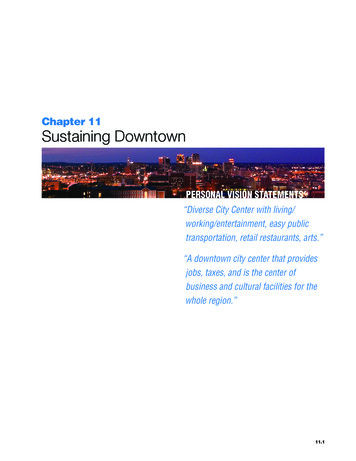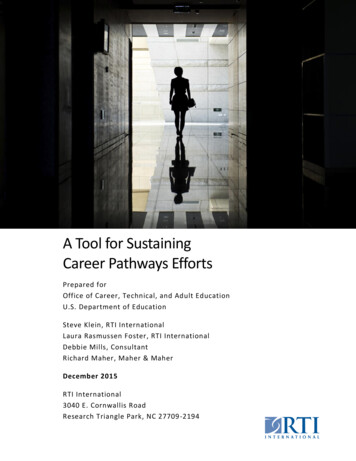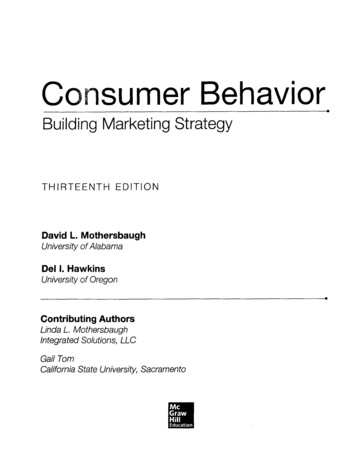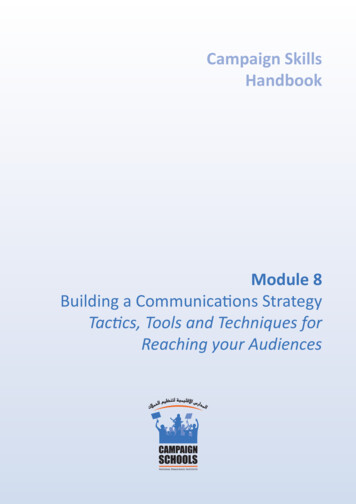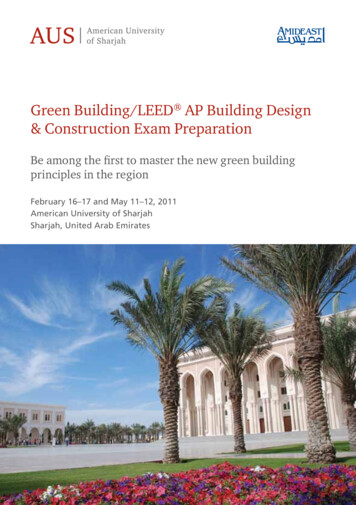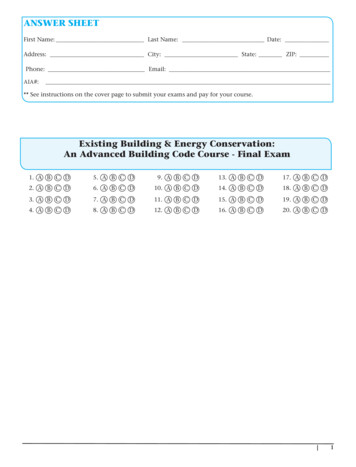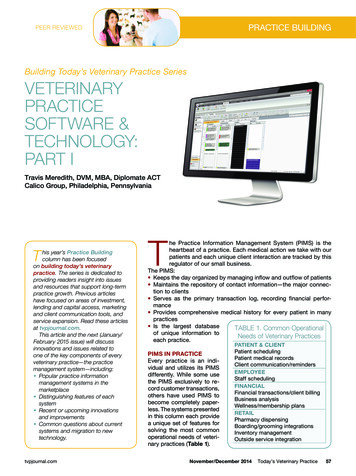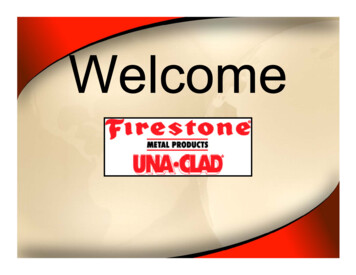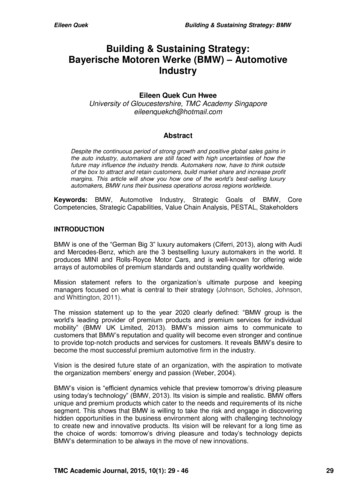
Transcription
Eileen QuekBuilding & Sustaining Strategy: BMWBuilding & Sustaining Strategy:Bayerische Motoren Werke (BMW) – AutomotiveIndustryEileen Quek Cun HweeUniversity of Gloucestershire, TMC Academy Singaporeeileenquekch@hotmail.comAbstractDespite the continuous period of strong growth and positive global sales gains inthe auto industry, automakers are still faced with high uncertainties of how thefuture may influence the industry trends. Automakers now, have to think outsideof the box to attract and retain customers, build market share and increase profitmargins. This article will show you how one of the world’s best-selling luxuryautomakers, BMW runs their business operations across regions worldwide.Keywords: BMW, Automotive Industry, Strategic Goals of BMW, CoreCompetencies, Strategic Capabilities, Value Chain Analysis, PESTAL, StakeholdersINTRODUCTIONBMW is one of the “German Big 3” luxury automakers (Ciferri, 2013), along with Audiand Mercedes-Benz, which are the 3 bestselling luxury automakers in the world. Itproduces MINI and Rolls-Royce Motor Cars, and is well-known for offering widearrays of automobiles of premium standards and outstanding quality worldwide.Mission statement refers to the organization’s ultimate purpose and keepingmanagers focused on what is central to their strategy (Johnson, Scholes, Johnson,and Whittington, 2011).The mission statement up to the year 2020 clearly defined: “BMW group is theworld’s leading provider of premium products and premium services for individualmobility” (BMW UK Limited, 2013). BMW’s mission aims to communicate tocustomers that BMW’s reputation and quality will become even stronger and continueto provide top-notch products and services for customers. It reveals BMW’s desire tobecome the most successful premium automotive firm in the industry.Vision is the desired future state of an organization, with the aspiration to motivatethe organization members’ energy and passion (Weber, 2004).BMW’s vision is “efficient dynamics vehicle that preview tomorrow’s driving pleasureusing today’s technology” (BMW, 2013). Its vision is simple and realistic. BMW offersunique and premium products which cater to the needs and requirements of its nichesegment. This shows that BMW is willing to take the risk and engage in discoveringhidden opportunities in the business environment along with challenging technologyto create new and innovative products. Its vision will be relevant for a long time asthe choice of words: tomorrow’s driving pleasure and today’s technology depictsBMW’s determination to be always in the move of new innovations.TMC Academic Journal, 2015, 10(1): 29 - 4629
Eileen QuekBuilding & Sustaining Strategy: BMWBoth BMW’s mission and vision are appropriate, for its survival in the premiumautomotive industry, to a relatively large extent. To keep up in the fierce competitionin this industry and grow its market share, BMW will have to constantly come up withnew and innovative products to become world’s number one in terms of reach,acceptance and revenue.According to BMW annual report (2012), BMW set its objectives to sell more than 2million automobiles annually by 2016 and target an increase of 8 to 10% in earningsbefore interest and tax margin in automotive segment. These objectives areexpressed in financial terms. The target is very specific as it states the desired saleslevels by a certain time period, to be achieved. It is measureable by the sales figures,closely relevant to its mission and most importantly, honestly achievable.Cardy and Leonard (2011) share a list of goals designed by BMW: Manufacture environmental friendly cars Stay ahead in the competition Help the society by being responsible Increase the sales all across the world Group-wide environmental protectionThese strategic goals of BMW are proven important and will affect the company inthe long run. It takes into concern of various aspects like the environment, society,business and product, portraying BMW as a corporate social responsibleorganization. However, the statements are vague such as it did not specify the timeperiod of the attainment of goals and are too broad to identify its focus areas such asgroup-wide environmental protection.STAKEHOLDERSStakeholders refers to individuals or groups who depend on an organisation to fulfiltheir own goals and on whom, in turn, the organisation depends on (Cwmifg, 2012).A stakeholder universe (Appendix A) shows all the stakeholders of BMW. They canbe categories into internal and external stakeholders (Bmw.co.uk, 2013).The stakeholder mapping uses power and interest matrix, which helps identifystakeholder expectations and power and understanding political priorities. This isessential as it greatly affects the company’s final decision.30TMC Academic Journal, 2015, 10(1): 29 - 46
Eileen QuekBuilding & Sustaining Strategy: BMWAdapted: Mendelow (1991) cited in Johnson, Scholes & Whittington, 2009, page 156.Key stakeholders of BMW: Competitors, customers, key shareholders, partners andexecutives.Customers are the users of the automobiles. Their power to influence the decision ofthe company is high as the spending power lies with them. BMW has to constantlyengage with the customers and keep them updated on the latest trend.Both BMW’s mission and vision are customer-oriented, emphasizing on theconsumers of their automobile. They aim to incorporate modern technology withhigh-class automobile to create a convenient and pleasant driving experience. Theyattempt to portray themselves as a lifestyle icon, but at the same time creatinguniqueness through diversity (Bart, 2010) via constant “upgrades” and changes to tryand satisfy customer’s needs alongside with technology advancement.With BMW as the global luxury leader, Audi and Mercedes have step up variousstrategies and efforts to topple BMW. To defend its premium leadership, BMW needsto monitor its competitors very closely for any new product launch or strategy in orderto respond swiftly. Any new strategy launch by competitors will threaten BMW’smarket share, acting as external pressure on BMW to carry out counteract measures.Key shareholders are investors of BMW, the source of its working capital. AppendixB depicts the BMW shareholder structure, with the Quandt family identified as thekey investors (Grin, 2012). They hold significant amount of shares, giving them greatpower to influence the company’s situation with their decisions. BMW have to keepthem satisfied and well-informed via the company’s annual financial and investorrelations reports.BMW’s financial objectives exist to satisfy these shareholders. With higher salestargets and sustainable profit margins in the long run, this increases shareholders’value and BMW’s credit rating.To maintain trust and good relationships with business partners, BMW have to shareinformation to keep them updated. Partners’ coordination and support are key factorsTMC Academic Journal, 2015, 10(1): 29 - 4631
Eileen QuekBuilding & Sustaining Strategy: BMWto BMW’s success. Executives are the management of BMW who hold authority tomake daily operations decisions, initiate strategies for new business developmentand manage the entire company. They have to know all details, trends and on-goingenvironmental changes which will affect BMW’s business performance.BMW goals attempt to satisfy a bigger group of stakeholders: interest groups andemployees. Being responsible for the environment, society and product, BMW is ableto establish good relations and reputation globally with entities such as the GreenPeace, Road Traffic Safety (Anton, 2008). BMW design their automobiles to reduceemissions and attain acceptable environmental standards in order to gain supportfrom various entities, which indirectly boost sales figure. Sustainable management ofthe company serves as great confidence for employees, in turn boosting workattitude and productive efficiency.BMW tries to strike a balance in satisfying all stakeholders’ interest but wasunsuccessful. Hence, it has to consider the ones with greatest impact on thecompany’s future performance. BMW must make decisions, at the cost of otherstakeholders’ interest, to achieve sustainable growth.PESTEL AnaylsisPESTEL stands for political, economic, social, technological, environmental and legalwhich describes a framework of macro-environmental factors used to analysis theimpact (Johnson, 2010) on BMW.Political environmentEurope introduces end-of-life directives whereby car manufacturers have to recyclevehicle parts like tires and airbags, posing additional recyclability and scraping costson BMW. BMW reacted by producing automobiles of at least 85% recyclable and upto 95% recoverable (Bridwell, 2009). However, the stringent directives still remain asa threat to BMW’s sustainability.The taxes and government policies are crucial to BMW’s success of automobiledemand in the global market. The Singapore government imposes high taxes onimported vehicles. A BMW 335i convertible costs 5 times more than the same car, inUS, after tax (Aquino, 2011). The implementation of the tax policy has resulted in adecrease in demand of the niche segment.Economic environmentAs BMW has production facilities located globally, it can spend its revenue in thesame currency. However, with different manufacturing models assigned to eachfactory, BMW will not able to match up its revenue with cost. Currently, BMW isexposed to high currency risk from US dollar, British Pound and Chinese Renminbi.These account for 65% of BMW’s total currency exposure (Automotive-Management,2011). When BMW settles a deal in foreign currency, an exchange rate hedge isconcluded to eliminate the risk.The cost of crude oil has a great influence on the price of manufacturing and demandof automobile; hence a rise in its cost will impact BMW in two negative ways. It isexpected to rise due to increased demand from emerging markets and in response;BMW develops “greener” automobiles like hybrid cars.Since the 2008 financial crisis, economic and business focus have shifted todeveloping economies in the Asia region. With rising global market position, thesecountries have capital flow surplus and its people now have higher buying power.32TMC Academic Journal, 2015, 10(1): 29 - 46
Eileen QuekBuilding & Sustaining Strategy: BMWIncreased wealth lead to rising consciousness of social status and this can benefitBMW in terms of higher demand. BMW can seize the opportunity to set up moreplants within the Southeast Asia region to enjoy low cost and high demand.Technological environmentBMW uses technology to gain competitive advantage in the production of engines,hence winning many glorious engineering awards in the industry.With rising awareness of global environmental phenomenon, it creates theopportunities for BMW to explore a new production direction by incorporating “green”technology into its business strategy. Having done in-depth research in hybridelectric cars and hydrogen cars, BMW aims to manufacture the most innovativeproduct. In the near future, BMW will continue its emphasis on developing new cleantechnologies for constant innovation and enhancement of its products.EnvironmentalWith increasing awareness of global phenomenon, there is a shift in consumers’preferences towards eco-friendly vehicles: hybrid and fuel cell cars. This affects thechange in demand for a different product line and new product directions.In BMW’s existing markets, environmental concern plays an important role of livingup to emission standards and environmental directives. BMW observed the changingtrend of customers’ preferences and support for “green” products, and thereforeresponded by increasing its focus on manufacturing more fuel-efficient automobiles.Through this, BMW achieved its lead on the Dow Jones sustainability index (Walsh,2012) and is working hard to stay ahead of sustainability in creating innovativesolutions.The PESTEL analysis suggests continuous improvement for BMW. The introductionof new regulations and tax policies are crucial political factors. Economic factors areidentified as having the most direct effect on BMW profitability. Despite increasingGDP, the various cost price increase and risk factors still pose as a threat to BMW.New technologies will contribute to sustainable solutions for “greener” products.These factors have both positive and negative outlook on BMW, and therefore BMWshould react on making the possible negative outlooks favourable.Porter’s 5 forces framework helps to identify an industry’s attractiveness in terms of 5competitive forces: threat of new entrants, threat of substitutes, power of buyers,power of suppliers and competitive rivalry. Dorian (2013) states they constitute theindustry profitability by evaluating the relative power each force holds, providing acomprehensive analysis for effective strategic decision making.Threat of new entrants: LOW / MODERATEDistinct brand imageBMW brand is defined by high marketing budgets and high quality inputs, thus isconsidered more luxurious and of better quality than other brands like Toyota andMazda. With a consistent well-distinct and established brand image since 1975,customers desire to make a statement with their purchase of a BMW automobile, justlike what BMW marketing ensure: sheer driving pleasure and the ultimate drivingmachine. This result in new entrants having to set aside high budget to brand theirproducts so it is as good as or even better than BMW, to attract customers.High initial R&D investmentsTMC Academic Journal, 2015, 10(1): 29 - 4633
Eileen QuekBuilding & Sustaining Strategy: BMWTo succeed in the premium automotive industry, the main focus is the continuousdevelopment of automobiles in terms of design, production, quality-management andtechnology. New entrants need to set up production factories, offices, showrooms,which amount to high fixed costs. Substantial capital for R&D investments is requiredto achieve an edge in innovations and BMW has al
With BMW as the global luxury leader, Audi and Mercedes have step up various strategies and efforts to topple BMW. To defend its premium leadership, BMW needs to monitor its competitors very closely for any new product launch or strategy in order to respond swiftly. Any new strategy launch by competitors will threaten BMW’sFile Size: 1MBPage Count: 18


